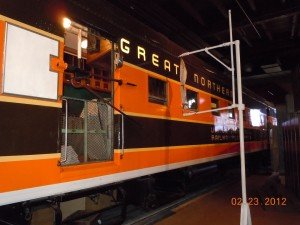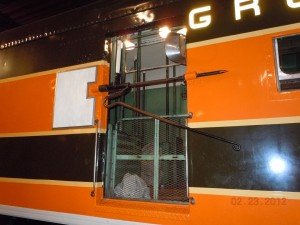There was a time when sending a letter by air was a big thing. In fact, to send your letter by airplane meant the purchase of a special airmail stamp with higher postage. This was the era when mail generally traveled by train. There were several reasons for this. Obviously the railroad could carry much more mail bags than an airplane. This was the era of the Railway Post Office Car. The history of trains has a lot to do with the U.S. Mail.

The earlier aircraft were not reliable enough the the mails. Schedules were either non existent or irregular. Secondly, during the latter 1800’s and the early 1900’s, railroad history tells us that trains went almost everywhere. Railroad routes were massive. All size towns and cities were connected by railroads and train mail services. Many of the rail tracks you see today used by freight trains while on a road vacation were once used by passenger trains. Most of those passenger trains had post office cars attached.
At one time trains had what was called an “RPO”, meaning railroad post office. These were official U.S. Post Offices that were on rolling train cars. Historically, the very first bag of mail carried on a United States train was reportedly in 1831. This may have been much earlier than most people would think. In the U.S., the official Railway Post Office began in 1862, midway during the American Civil War, using converted train baggage cars. The first route ran in Missouri. This particular route was short lived and the first permanent railway post office was established in 1864. These first RPO’s were not originally designed as rolling post offices. The first designs used simple furniture and desks. Later, the designs would resemble small post office’s. This included sorting tables and individual boxes lined on the walls.

The Railroad Post Office system kept growing and by the 1880’s the majority of passenger trains included these special cars. One reason this system worked so efficiently was that the train could both drop off mail bags and pick a bag up without stopping. This meant that even the smallest of towns, without a formal train depot, could exchange mail because of the post office car. You may have seen the apparatus used in picking up mail while in motion. Essentially it was a pole that had a mail bag attached at the top and bottom. The moving train would simply pass by and a special steel arm would extend from the mail car and snatch up the bag. As soon as the waiting bag was picked up and swung into the rail car the bag waiting to be dropped off would be shoved out the door. A bit of coordination was required to successfully operate the post office car but the system worked well. The idea was both ingenious and very simple at the same time and worked on trains that could be traveling past a town at maybe 70 MPH. Most of these railroad post office cars also had exterior slots which meant people could manually deposit mail into it when the train was stopped at a station. It served in a way as a portable mail box. Mail that was deposited like this received an official RPO postmark.

Mail sorting would be done by the postal workers as the train was moving and prepare bags to be dropped off. Eventually, the United States Post office put forth a floor plan design that would be used in all post office cars. The standardization would help with efficiency since mail clerks could be assigned to different cars. Having all cars designed the same meant that a clerk would be accustomed to the routine and work more efficiently. Less chance of sorting errors as well. The standardization began in 1885. As far as the outside of the post office cars appeared during the latter 1880’s, railroad history tells us that all cars were painted a standard color, mostly white with a darker trim. Beginning in 1890 the railroad post office cars were painted in a color scheme that would match the particular railroad it was operating on. The pictures of the Great Northern Railway post office car in this article is an example of that.
The peak year for the railway post office system is though to be about 1930. During that year nearly 10,000 trains were employed to pick up and deliver mail to just about any town or city in the U.S., large and small. There were dedicated mail trains. The dedicated mail train could transport huge volumes of mail. Post office cars were virtually seen on every passenger train. Alternatives such as airmail and trucking were really not a factor during that time. Even highways like Route 66 were fairly new during that period. It would take advances in highway construction, especially the Interstates, that would eventually change things.
Railroad history and the vintage post office rail cars are now preserved at several museums around the United States. Some of these historic post office rail cars are on permanent display. One is the Galesburg Railroad Museum located in Galesburg Illinois. The RPO car displayed there was built in 1924 and taken out of service in 1960. The car is about 70 feet in length and about 14 feet high. Another RPO car is on display at the California State Railroad Museum in Old Town Sacramento California. The RPO car on display there is the old Great Northern Railway #42. The post office rail car was built in 1950 by the American Car and Foundry. It was made to be placed directly behind the locomotive. RPO cars were owned by the railway, but leased to the Postal Service and were staffed by postal employees. Another railway post office car is on display at the Pacific Southwest Railway Museum Association in Campo California. This RPO car is the old Atchison Topeka & Santa Fe Railroads #74. This rail car was built by the Pullman Car & Mfg. Corp. in 1927. It has six barred windows and two sliding doors on each side, and is equipped with electric lighting & screened fans. After restoration the car took its inaugural run to Tecate, Mexico on November 23, 2002. The Houston Railroad Museum in Houston Texas has on display an Atchison Topeka & Santa Fe Baggage-Railway Post Office Car # 3401 built in 1938 by the Budd Co. This particular car saw service on many routes including the Chicago to Houston Texas Chief. The 3401 is one of the earliest streamlined RPO cars built for any railroad.
Two related railroad articles you should find interesting are the Atchison Topeka & Santa Fe and dining cars and the Central Pacific Railroad.

Slowly but surely the railroad post office cars were phased out. The decline began in 1948. During that year RPO’s were operating over some 161,000 route miles of track in North America. This was down from the peak of over 200,000 route miles. In 1942, the Post Office department were beginning to use highway vehicle to transport mail. The original intention was to have the highway trucks augment the service from the RPO’s but by the 1950’s and 60’s it was evident that the highway vehicles would go on to replace the railway service. The final blow came in 1967 when the Post Office Department canceled all of it’s railroad contracts and elected to transport first-class mail by either aircraft or highway trucks.
An interesting side note is that when the railroad post office contracts were canceled, a good deal of passenger train service would also be canceled not long afterward. The railroads lost a tremendous amount of revenue when the Post Office Department pulled out. Revenue from mail contracts were critical to the transportation industry in general. When you look back at the early stagecoach lines during the days of the old west, their existence and operating revenue was derived from mail contracts. Passenger revenue was a secondary source of money. Mail contracts supplied a continual revenue stream that couldn’t be duplicated from passenger only service. The famous Butterfield Overland Stage Line and others were possible only because they won mail contracts from the U.S. government. The business model of a mail contract and passenger revenue seemed to be the winning combination Today, the private railroads carry freight and they appear to be making good profits in so doing. Passenger service in the U.S. is provided by Amtrak, a government run railroad. It is very doubtful that a private concern could or would want to establish passenger rail service in the U.S. because of the staggering costs alone and the unpredictability of passenger demand. It’s a great thing that these vintage railroad post office cars have been preserved and restored so that future generations can learn about this most unique time in American railroading.

